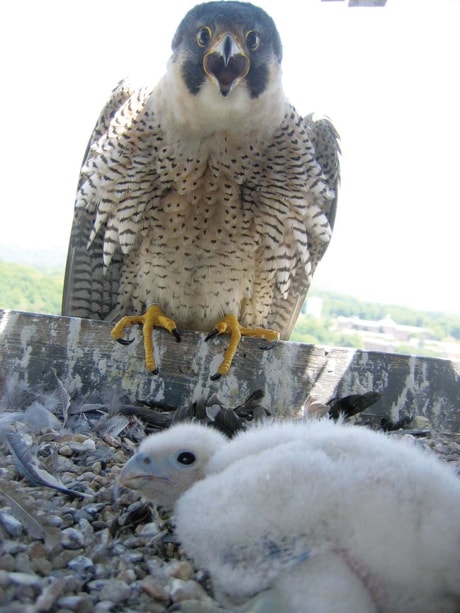I just love this time of year.
I’m out constantly looking for owl’s nest and trying to find my “firsts of the season.”
Apparently the peregrine falcons have returned to Red Deer but I haven’t been lucky enough to spot one yet.
But soon, if all goes well, we should all be able to get wonderful views of them. The Red Deer River Naturalists with the assistance of Telus will be installing a webcam in the nest box at the top of the Telus radio tower in Highland Green.
A nesting box had been placed high up on that tower about 10 years ago to help the peregrine falcons. These birds had been one of the species hardest hit by DDT.
In the 1970s we were down to one breeding pair in the province.
The peregrine falcons were placed on the endangered species list in 1978.
However, with a captive bird breeding and release program as well as the ban on DDT, the population has increased and these falcons were downlisted to threatened status in 1999.
Peregrines are a large falcon (41-51 cm in length and a wingspan of 91-112 cm).
They have a distinctive dark tear drop marking on their face. They typically dive down on their prey from up high.
This dive is called a stoop and it is believed that peregrines in a dive may attain speeds over 300 km/h.
I looked up the word “peregrine” in a dictionary and it means traveller or wanderer.
I also read an article in a magazine, Nature Alberta (Volume 39 No. 1 1 Spring 2009).
The authors, Geoff Holroyd and Helen Trefry, described one particular peregrine’s migration from Panama back to Edmonton in the spring of 2008. A female bird named “Homeless” had been radio collared so they knew exactly where she was. She left Panama on April 4 and arrived in Edmonton on April 26.
A couple of spring storms had held her up for a few days but she seemed to be travelling between 300 to 500 km/day.
This is quite an interesting article; I would recommend that people read it.
But back to our proposed webcam.
Fish and Wildlife have provided a new and improved nest box for the birds.
The one that is up on the tower is old and probably in poor repair.
The new one has vertical bars in the opening which the falcons can get through but predators, like ravens and owls, can’t.
Telus is providing the labour to get the new box that will have the camera already installed in it up to the top of the tower.
The Red Deer River Naturalists bought the camera and other equipment necessary.
The camera will be able to see the entire inside of the box so it won’t matter which corner of the box, mama peregrine decides to use; we’ll still be able to see her.
We’re even going to be able to hear what’s going on up there. We aren’t putting in any lights, though, so at night, the view of the peregrines won’t be possible.
We have to give them some privacy, right?
Red Deer’s webcam will be available at www.rdrn.fanweb.ca.
According to the University of Alberta website (http://www.falconcam.med.ualberta.ca/info.html) we can expect to see courtship between the pair of birds in late April to early May. The eggs will be laid early to mid May. The eggs hatch mid to late June and the babies fledge late July to early August.
I can hardly wait.
(The webcam was to be installed Tuesday. The raptors should arrive in about two weeks.)
Judy Boyd is a naturalist with the Red Deer River Naturalists.
